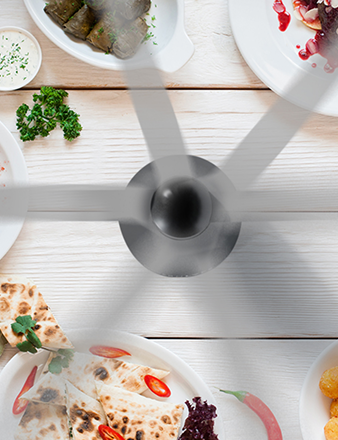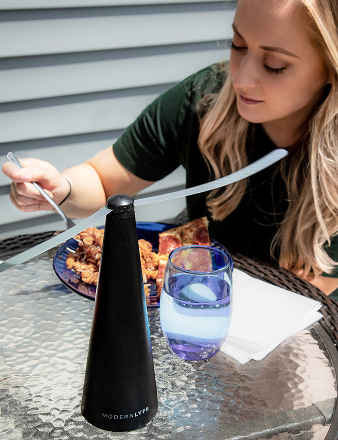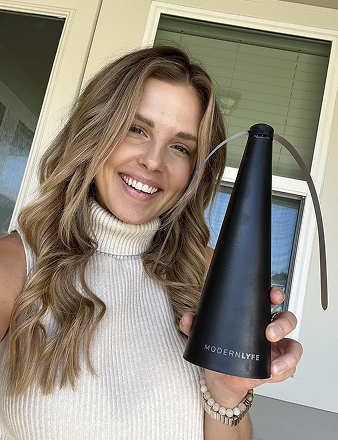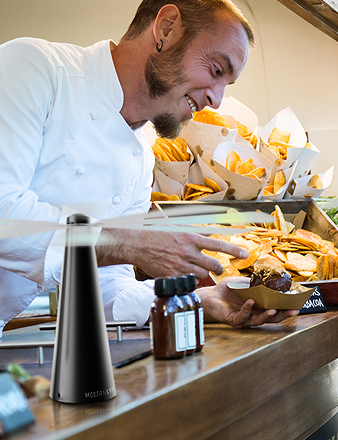An over-the-door fly fan, also known as an air curtain, is a simple, effective tool for keeping flies and other pests out of your business. It works by creating a powerful, invisible barrier of air that physically blocks insects from flying through an open doorway.
This approach offers a chemical-free, hands-free, and energy-efficient solution for keeping sensitive areas like kitchens, dining rooms, and event spaces hygienic and comfortable.
Your First Line Of Defense Against Pests
Think of an over-the-door fly fan as an invisible force field for your entrance. Mounted directly above a doorway, it pushes a continuous, high-speed stream of air straight down.
This downward force creates an "air curtain" that small flying insects can't penetrate. It's a game-changer compared to bulky screen doors or chemical sprays because it allows people and carts to move in and out freely while pests stay outside.
This simple technology has become essential for modern pest control, especially in the hospitality industry. It’s not just about preventing flies from bothering your guests; it’s about upholding critical food safety standards—a non-negotiable for any restaurant, cafe, or event venue.
Key Features and Immediate Benefits
The benefits go far beyond just blocking bugs. These fans are designed specifically for commercial spaces where ambiance and smooth operations are critical. For a deeper look into how different types of fans work, check out our comprehensive guide on fly fans.
Here’s a breakdown of the core features and the benefits you'll see right away.
Key Features Of Over The Door Fly Fans
| Feature | Benefit |
|---|---|
| Air Curtain Technology | Creates an effective, non-physical barrier that stops insects in their tracks. |
| Low-Noise Operation | Maintains a quiet and pleasant atmosphere for guests and staff. |
| Energy-Efficient Motor | Lowers operating costs, especially compared to always-on HVAC systems. |
| Hands-Free Protection | Allows for seamless entry and exit without the hassle of a screen door. |
The move toward smart solutions like these is part of a larger trend. The global fan industry, valued at $11.1 billion in 2021, is projected to hit $16.9 billion by 2031. This growth shows how much businesses are investing in effective air movement to solve everyday problems.
Understanding How They Work
How can a simple fan keep a room full of food completely fly-free? It all comes down to physics. An over-the-door fly fan acts like an invisible bouncer for your doorway, using a powerful, focused stream of air that insects can't push through.
The technology behind it is the air curtain: a steady, downward-flowing sheet of air the fan creates from the top of the door frame to the floor. For flies, mosquitoes, and other small pests, trying to fly through this invisible wall is like trying to walk through a hurricane. It's not going to happen.
For this to work, the air curtain must be strong and consistent, covering the entire doorway without weak spots, even as people walk through. That's why the fan's power and design are so important—they ensure that invisible barrier stays active and effective.
This overview shows how the primary job of creating an invisible barrier is supported by other key features that make it ideal for businesses.

As you can see, it’s not just about stopping bugs. It’s about doing it quietly and efficiently, without disrupting your customers or your energy bill.
What Makes the Air Barrier Effective?
It's not just about blasting air. The effectiveness comes down to the science of airflow. Three key factors determine whether you have a fly-free zone or a failed experiment. Getting these right is critical.
The secret to a great air curtain is its ability to push air down at a consistent speed, from the fan to the floor. This creates a solid, gap-free shield that pests can’t sneak through.
Here are the terms that matter:
- Airflow Rate (CFM): This is the volume of air the fan moves, measured in Cubic Feet per Minute (CFM). Higher CFM means a stronger air curtain, which is essential for larger doorways or high-traffic areas.
- Mounting Height: Where you install the fan is crucial. Too high, and the airflow weakens before it hits the ground. Too low, and it becomes an obstacle. Every fan has an ideal height for peak performance.
- Decibel Level (dB): This is how loud the fan is. In a restaurant or event space, you need a unit that works without being a noisy distraction. A fan running around 50-60 dB is about as loud as a quiet conversation, making it perfect for maintaining a pleasant atmosphere.
Businesses are catching on. The market for specialized ventilation fans is expected to grow from $3.33 billion in 2024 to $6.27 billion by 2033. This reflects a major shift toward smarter, targeted air control solutions. You can discover more insights about this growing market to see where the industry is headed.
Benefits and Real-World Applications
Imagine a busy outdoor patio on a warm evening. An over-the-door fly fan works almost silently, creating an invisible shield that keeps flies from ruining the atmosphere. Guests relax and enjoy their meals without swatting at pests. That's the simple, powerful promise of an air curtain.
At a local restaurant, Bistro Verde, the staff installed a fly fan above their main entrance. The result? An 85% drop in negative online reviews mentioning insects. Fewer complaints led to better ratings and happier, returning customers.
This isn't just for traditional businesses. Food trucks are a perfect example. A sleek fan mounted over the service window acts as a constant guard against airborne pests, which is crucial for maintaining hygiene on a busy street.
The savings add up, too. By eliminating the need for sprays, traps, and professional pest control services, a typical venue can save around $1,200 a year. That’s money that can go directly into menu development or staff training.
- It's a chemical-free barrier, so no sticky traps or toxic residues.
- The protection is continuous, working hardest during your busiest hours.
- Energy use is minimal, typically under 50 watts.
- They operate quietly, usually below 60 dB, so they won't disturb the ambiance.
These fans just make sense in a fast-paced environment. Your staff can stop worrying about swatting flies and focus on what they do best: serving guests.
Chemical-Free Pest Control
So, how does it work without chemicals? The fan directs a powerful, focused column of air straight down, creating an invisible wall that insects simply can't fly through. It’s a physical barrier made of air, which means no chemical residue on food, counters, or tables.
This approach means you can skip the costly and disruptive shutdowns required for chemical fumigation, keeping your doors open and business flowing. Plus, you won't have to deal with special EPA permits or posting warning signs.
"We cut our fly complaints by 70% almost overnight, and we didn't use a single chemical spray," says Chef Nadia.
It’s a smart, modern solution that aligns with today’s health codes and guest expectations for a clean, safe dining experience.
More Than Just Pest Control: Comfort and Cost Savings
Beyond keeping bugs out, these fans have a pleasant side effect: a gentle breeze for incoming guests. As the door opens, people are greeted with a subtle, refreshing puff of air—a small touch that enhances the guest experience.
Financially, the comparison to other solutions is stark. An air curtain uses about 80% less energy than a dedicated entryway A/C unit. Some hotels have reported a 15% reduction in the workload on their main HVAC system near the entrance. Over a year, the energy savings alone can easily top $900 per location.
- Install it above your main entrance to block insects and give guests a cool welcome.
- Adjust the fan speed to find the perfect balance between barrier strength and quiet operation.
- Use it alongside your main HVAC system for an extra boost of comfort in high-traffic areas.
This dual benefit of enhanced comfort and serious cost savings makes fly fans a smart investment for any hospitality business.
Where You'll See Them in Action
In high-end restaurants, you’ll often find these fans mounted over the swinging doors between the kitchen and the dining room. They keep staff comfortable, prevent pests from entering the kitchen, and help contain heat from ovens, improving AC efficiency.
Outdoor weddings and events are another prime use case. A fan placed over a buffet line creates a clean, protective curtain of air. Guests can mingle without batting away insects, and servers can move in and out of the service line without a problem.
Food trucks can mount portable units for a pest shield they can take anywhere. Many battery-powered models run for up to 12 hours on a single charge, making them perfect for long days at markets or food festivals.
| Venue Type | Common Scenario | Typical Result |
|---|---|---|
| Fine Dining | Over the patio entrance | 80% fewer insect complaints from guests. |
| Food Truck | Above the service window | Zero pests reported inside over a 30-day period. |
| Catering | Protecting a buffet line | Faster, more pleasant service and better event ratings. |
Maintenance is straightforward. A quick weekly wipe-down of the fan blades and housing prevents dust buildup. If you have a battery model, you’ll want to replace the batteries every 12 months, or just opt for a hardwired version for nonstop operation. It’s also a good idea to do a monthly check on the mounting brackets and tighten any loose screws to keep the unit secure.
Pro Tip: For the best results, angle the fan slightly inward. This small adjustment helps optimize the airflow and creates an even more effective barrier against insects.
Ultimately, these fans help you deliver seamless service without the daily frustration of pests.
- For temporary events like tradeshows, look for models with snap-in brackets for quick, tool-free installation and relocation.
- A good warranty is key. Most quality fans come with two years of coverage that includes unlimited support and 24/7 service.
Ideal Placement And Installation Tips
Proper placement of your over-the-door fly fan is critical. The goal is to create an unbroken curtain of air that seals the entire doorway, leaving no gaps for pests to slip through.
The ideal spot is directly above the center of the door frame. This ensures a balanced, even flow of air across the entire opening. For a standard single door, choose a fan that’s slightly wider than the door itself to create a powerful, top-to-bottom shield.
This isn't just about moving air; it's about precision. Strategic placement turns a simple fan into a formidable, invisible wall that insects can't breach.

Finding The Sweet Spot For Your Fan
Where you mount the fan depends on where you need it most. High-traffic areas are the top priority, but the basic rule is to target any opening where food is present and pests are a problem.
- Main Entrances: This is a clear choice. A fan here keeps bugs out while greeting guests with a gentle, welcoming breeze.
- Back-of-House Doors: Kitchen and delivery doors are open invitations for flies. A fan here is essential for keeping food prep areas hygienic and compliant with health codes.
- Service Counters & Pass-Through Windows: Food trucks, concession stands, and walk-up windows can protect their food right at the point of service with a well-aimed air curtain.
The optimal mounting height is typically between 7 and 10 feet from the floor. If you go too high, the air stream loses power before it reaches the ground, leaving a weak spot at the bottom that insects will find.
Sticking to this height ensures the air maintains enough velocity to form a solid, continuous barrier. For a deeper dive into how placement affects performance, check out our guide on using door fans to keep bugs out.
A Step-By-Step Installation Checklist
Installing an over-the-door fly fan is straightforward, but doing it right guarantees it works perfectly and stays secure. A rushed installation can lead to annoying vibrations or an ineffective air curtain.
Before you start, gather your tools: a drill, a level, a measuring tape, and the included mounting hardware.
- Measure Your Doorway: First, confirm the fan is wide enough. It should cover the entire opening, ideally with a slight overhang on each side for total coverage.
- Mark Mounting Points: Use a level to mark where the mounting brackets will go above the door frame. Keeping them perfectly horizontal is key for effective airflow.
- Secure The Brackets: Drill pilot holes and screw the brackets firmly to the wall. Use wall anchors if you're installing into drywall for a secure fit.
- Mount The Fan: Carefully lift the fan and attach it to the brackets. Wiggle it gently to ensure it's locked in securely before letting go.
- Test The Airflow: Turn it on and feel the air current. It should flow straight down and feel consistent all the way to the floor. If you notice any gaps, you may need to adjust the angle slightly.
Maintenance And Quietness Considerations
Keeping your over-the-door fly fan in top shape is simple. A little regular attention ensures it stays efficient and quiet for years. Dust and debris are the main culprits that slow airflow and make motors work harder.
A quick weekly wipe-down of the blades and housing with a damp cloth is usually enough. Once a month, check the air intake vents and clear away any buildup. This simple routine keeps your invisible pest barrier strong.
Think of this as a monthly tune-up for your invisible shield. A few minutes of care keeps your air curtain powerful, quiet, and ready to protect.
Adopting these small habits saves you time, money, and frustration, while also extending the lifespan of your fan.
Choosing Your Power Source
When it comes to power, you have two solid options: battery-powered or hardwired. Battery units are perfect for mobile setups like food trucks, pop-up stalls, or outdoor events where outlets are scarce. The global portable misting fans market is expected to hit $4,284.18 million by 2035. For more on this trend, you can discover more insights about this rapidly growing market.
Hardwired fans, on the other hand, offer set-it-and-forget-it reliability for permanent venues. Once installed, they draw steady power without needing battery swaps, making them a favorite in busy restaurants and hotels where downtime isn't an option.
Here’s a quick comparison:
- Battery-Powered: Best for temporary setups, no wiring required, and complete mobility.
- Hardwired: Delivers uninterrupted power, ideal for fixed doorways in high-traffic areas.
Keeping Things Quiet
In hospitality, ambiance is everything—and a noisy fan can ruin it. Fortunately, most modern over-the-door fly fans run at 50 to 60 decibels, about the volume of a quiet conversation.
To maintain that gentle hum, focus on a solid installation:
- Use Vibration Dampers: Place rubber or silicone pads between the bracket and the wall to absorb vibrations.
- Ensure a Tight Fit: Double-check every screw and mounting point—loose hardware is a common cause of rattles.
With these small adjustments, your fly fan will blend seamlessly into your space, quietly doing its job without becoming a distraction.
Buying Guide And Specification Checklist
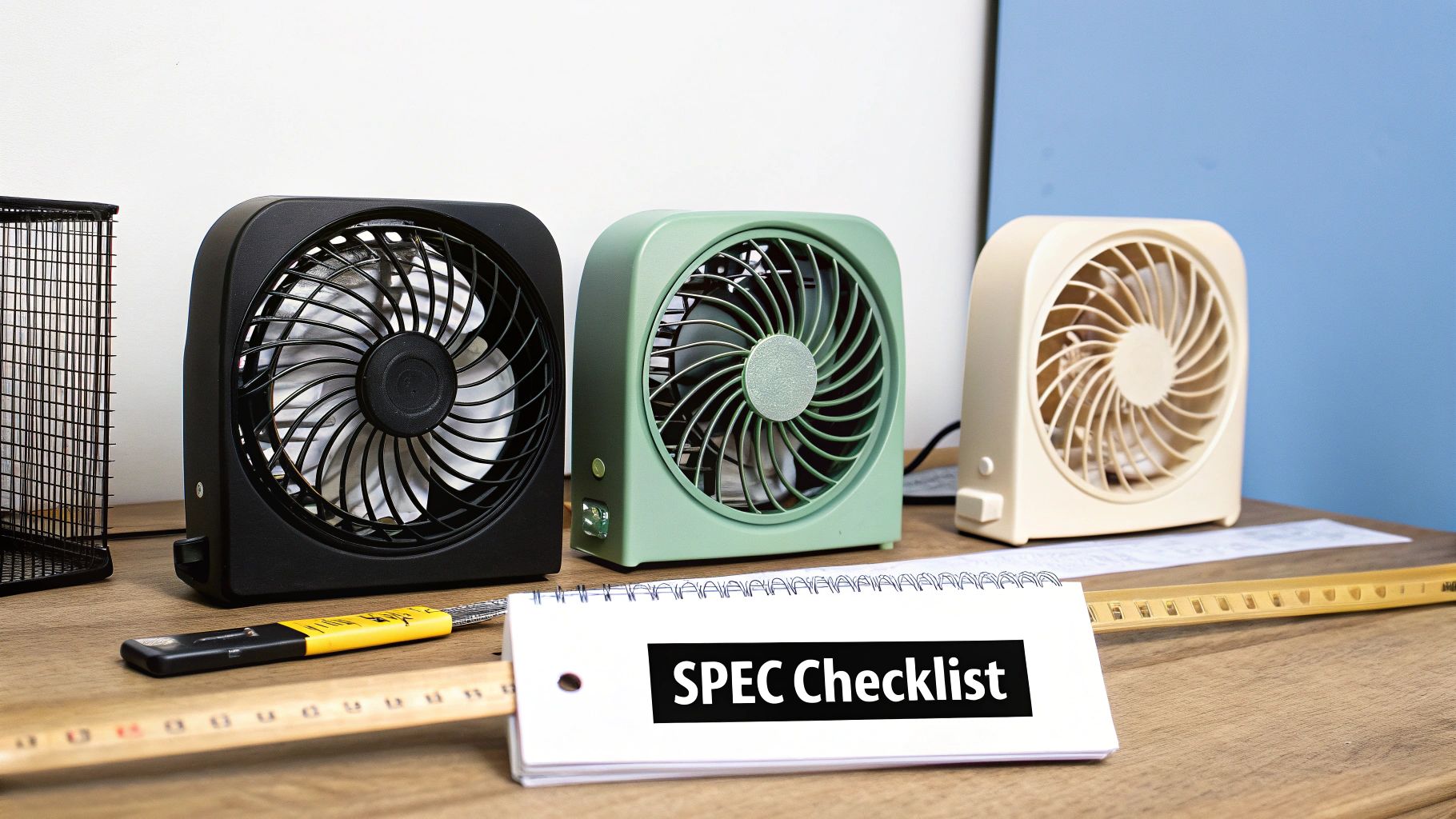
When you're ready to buy an over-the-door fly fan, you need the right power and features for your space without overspending on something you don't need.
Let’s walk through the specs that matter. From door width to motor noise, every detail plays a role in creating the invisible shield that keeps your establishment pest-free.
Door Width And Airflow Rate
First, measure your door. An over the door fly fan that's too short is like a fence with an open gate. Your fan needs to be at least as wide as the doorway, and ideally, extend a few inches on each side to guarantee complete coverage.
Once you have the right size, look at the airflow rate, measured in Cubic Feet per Minute (CFM). Think of CFM as the "strength" of the air curtain. A higher CFM creates a more powerful wall of air, which is essential for taller doorways or areas with a cross-breeze.
For a standard 36-inch commercial door, look for a fan that delivers at least 1,200 CFM. This provides enough force to keep the air curtain intact from top to bottom, effectively blocking insects.
Getting the width and airflow right is the foundation of an effective setup.
Noise Level And Power Source
In any customer-facing business, the atmosphere is key. A noisy fan can be a major distraction, which makes the noise level—measured in decibels (dB)—a critical spec. Most quality fly fans are designed to be quiet, typically operating between 50-60 dB. That’s about the volume of a normal conversation, so it will blend into the background.
Next, decide on your power source.
- Battery-operated fans are perfect for mobile setups like food trucks or temporary outdoor events.
- Hardwired units are the workhorses for permanent locations like restaurants or hotel lobbies, offering a reliable, set-it-and-forget-it solution.
The right choice depends on where and how you’ll be using it.
Durability And Warranty
Commercial environments are tough on equipment. You need an over the door fly fan built to last. Look for models made with durable materials like stainless steel or high-grade ABS plastic. These materials stand up to daily wear and tear, resist corrosion, and are easy to clean.
Finally, always check the warranty. A multi-year warranty shows the manufacturer's confidence in their product's longevity. It’s your safety net, protecting your investment and ensuring you have support if anything goes wrong. For a deeper dive into different models, you can learn more about choosing the right commercial fly fan in our detailed guide.
To simplify your search, here’s a quick checklist to use as you compare models.
Specification Checklist For Over The Door Fly Fans
This table breaks down the key features to look for and why they matter for your business.
| Specification | Why It Matters |
|---|---|
| Door Width Compatibility | Ensures the fan creates an air curtain that completely covers the entryway without gaps. |
| Airflow Rate (CFM) | Determines the strength of the air barrier, crucial for effectiveness in various conditions. |
| Noise Level (Decibels) | Protects your venue's ambiance by ensuring the fan operates without disturbing guests. |
| Power Source | Dictates whether the fan is better suited for mobile applications or permanent installations. |
| Durability (Materials) | Guarantees the unit can handle the demands of a commercial setting and is easy to maintain. |
| Warranty | Provides peace of mind and support, safeguarding your investment for the long term. |
Using this checklist will help you confidently select a fan that’s perfectly suited to protect your space, your customers, and your reputation.
Got Questions? We've Got Answers
Still have questions? You're not alone. Here are the most common questions we hear from business owners, with straight-to-the-point answers.
How Well Do These Fans Hold Up to Constant Use?
They're built to last. Commercial-grade fly fans are designed for the non-stop demands of the hospitality industry.
They are typically made from durable materials like stainless steel or high-impact ABS plastic and engineered to run for thousands of hours without issues. A little routine cleaning to prevent dust buildup is all it takes to keep a fan running reliably for years.
What's Usually Covered by the Warranty?
A solid warranty is a manufacturer's promise of quality. For most fly fans, you can expect a warranty covering defects in materials or craftsmanship for one to two years.
Here’s what that typically includes:
- Parts and Labor: If a component fails due to a manufacturing issue, the cost to repair or replace it is covered.
- Motor Guarantee: The motor is the core of the fan, so it often gets special attention in the warranty.
Be sure to read the warranty before you buy. Issues caused by improper installation or lack of basic maintenance are usually not covered.
Think of a good warranty as a sign of quality. When a company is confident enough to back its product for a couple of years, it tells you they've built it to last.
Should I Install It Myself or Hire a Pro?
This depends on the type of fan you choose. If you're going with a smaller, battery-powered model, you can likely handle the installation yourself. They usually come with straightforward mounting hardware and instructions.
For larger, hardwired units, we always recommend hiring a professional. An electrician will ensure everything is wired safely and up to code. They’ll also mount it securely to prevent rattling and noise, guaranteeing the air curtain works exactly as it should.
Ready to create a more comfortable and hygienic environment for your guests? Explore the full range of quiet, effective pest control solutions from MODERN LYFE and find the perfect fly fan for your needs. Visit us at https://modernlyfe.com to learn more.

